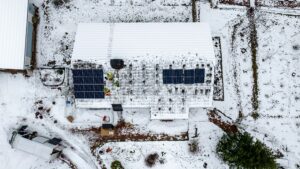As winter approaches, making sure your solar panels are properly prepared helps maintain their efficiency during shorter, cloudier days. While solar panel maintenance is typically minimal, taking time to clean, inspect, and prep them for winter maximizes their energy output.
Here are some steps to help you winterize your solar panels.
Dirt, dust, leaves, and other debris build up on solar panels, blocking sunlight and reducing efficiency. This is especially important during winter, as cloudy days and shorter daylight hours already limit available sunlight.
A clean surface allows panels to capture as much sunlight as possible. Here’s how to clean them effectively:
Pro Tip: Avoid metal tools or high-pressure water, as these can damage the panels; a gentle approach ensures safe, effective snow removal to maintain energy production.
Learn more about winter solar panel efficiency here: Keeping Your Solar Panels Efficient During Winter Weather: What You Need to Know
A thorough solar inspection helps catch potential issues before winter’s harsher conditions make them worse. Regular inspection involves checking for cracks, loose wiring, or other signs of damage that might compromise performance or pose safety risks.

Pro Tip: To get the most energy from your solar panels, align them to maximize their exposure to sunlight. Ideally, the tilt angle of your solar panels should match your latitude for year-round performance.
For more info on solar panel alignment, read our article: The Importance of Solar Panel Alignment
During winter, the sun is lower in the sky, so adjusting the angle of your panels can help capture more sunlight. If your mounting system allows it, tilt your panels to a steeper angle for optimal winter performance. This adjustment ensures that the panels receive more direct sunlight, improving efficiency.
For ground-mounted systems, this can be done fairly easily, but rooftop systems may require professional adjustment depending on the setup.
Installing a monitoring system allows you to track the performance of your solar panels throughout the winter. This helps you identify drops in efficiency quickly, so you can address issues like snow buildup or damaged wiring without delay. Additionally, if you use solar batteries, ensure they’re properly insulated to withstand colder temperatures, which can reduce their efficiency.

If your panels are due for professional solar panel maintenance or inspection, schedule this before the winter season. A professional can conduct a more in-depth inspection, identify issues that might not be visible, and ensure your system is optimally prepared for winter conditions.
Winterizing your solar panels helps ensure they operate at peak efficiency throughout the colder months. By cleaning, inspecting, adjusting, and maintaining your panels, you can make the most of winter’s limited sunlight and protect your investment for years to come.
Contact Gurr Brothers Energy today for all your seasonal solar needs!
Author: Hunter S.
Give Gurr Brothers Energy a call today and let’s start powering your life with sunshine!